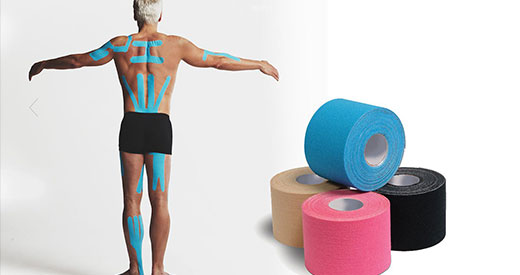Ah, summer: the magical time of year where we make up for all the time cooped up indoors for the winter and get involved in any and all activities we can. Bicycles, rollerblading, marathons and sports galore… what could possibly go wrong?
You know the answer just as well as we do. Sports injuries take all the fun out of summertime activities, but they don’t have to limit you like they did before. Used by Olympic athletes worldwide, kineso tape offers an alternative to physical supports that promotes the freedom of movement. While you prepare for your own summer Olympic games, consider kineso tape as your new go-to for soft-tissue support:
Why is kineso tape better than a brace?
While bracing is important for severe injuries, it also adds an element of immobilization to the injured area. In doing so, the area weakens, while the opposite side does double the work to balance out the brace. This short term change often leads to a long term imbalance in how you move. Always consult with a physiotherapist before applying any kind of support device. Depending on the severity of your condition, a brace may be recommended for use during select activities, but not for consistent, continued wear. Ultimately, the brace may just be too much support for the injury; over-guarding a vulnerable area does not make it stronger.
What does it do?
Kinesotape is an elastic taping material used to support unstable structures in your body. Sold in a variety of colours, sizes, and tension grades, it is used to stabilize sprains and strains in muscles, tendons, and ligaments, by providing flexible but durable support that does not inhibit your range of motion. Drug free, latex free, water resistant, kineso tape can last up to 5 days depending on your activity level. Unlike conventional taping methods, the kineso tape is lightweight and comfortable, promoting correct proprioception while you heal. The shape, direction, and tension of the tape application depend on the injury and its location.
Through therapeutic taping, your physiotherapist can help you retrain your muscles, minimize pain and swelling, increase circulation (especially for bruising), prevent further injury, and above all, promote healing of the affected area to get you back to your activities, pain-free. Always consult with your physiotherapist for when you are safe to return to sports after an injury; too much activity too soon can reinjure the area and aggravate an already vulnerable soft tissue or joint.
Where can I buy Kineso tape?
Kineso tape is available in stores, pharmacies, and online wherever physiotherapy products are sold. Major name brands include SpiderTech and KT tape. The tape is sold either as a role or in pre-cut section strips. Some kits are sold in fans or thinner bands that are specialized for particular injury types or body regions.
Can I apply it by myself?
For optimum results, we strongly encourage you to be taped by a licensed physiotherapist during a physiotherapy session. The physiotherapist will also apply some therapeutic modalities to work towards pain management. With proper education from a physiotherapist, patients are often able to independently and successfully apply kinesotape to some regions under proper instruction. For areas that are more difficult to reach, such as shoulder and back, you may require assistance.
When shouldn’t I use Kineso tape?
Kineso tape will not replace rigid supports like braces or splints for severe injury, nor will it replace medical tape or stitches for open wounds. Do not use kineso tape over areas where the skin is irritated, broken, or showing signs of infection. Kineso tape should also not be used over fresh stitches or staples following any surgical procedures. Should any itching occur while the tape is applied, remove it; this may be a sign of allergic reaction to the adhesive agent in the tape.
For more information on conditions that can benefit from our kineso taping service please visit our webpage.
